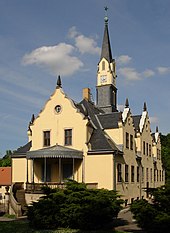Carl Friedrich August Dathe von Burgk
Carl Friedrich August Freiherr Dathe von Burgk (until 1829 Carl Friedrich August Krebß ; born April 29, 1791 in Dresden ; † July 26, 1872 there ) was a coal and steel entrepreneur and a pioneer for today's health insurances and miners' associations .
Live and act
Karl Friedrich August Krebß was born the son of a councilor of war in Saxony. He attended the Kreuzschule Dresden and then completed a law degree at the University of Leipzig . Between 1813 and 1822 he completed a military career as a lieutenant and was a member of the banner of the voluntary Saxons .
Krebß was fascinated by mining from a young age. The opportunity to work in the mining industry arose when in 1819 he inherited the Burgk manor, including five associated hard coal pits, from the property of his aunt Wilhelmine Sophie Dathe. After buying a nobility diploma, Krebß called himself Freiherr Dathe von Burgk.
In 1833/34 he was a deputy member of the manor owners of the Meissen district of the II. Chamber of the Saxon state parliament .
By buying additional coal fields, he founded the Baron von Burgker Steinkohlen- und Eisenhüttenwerke in 1819 , which enjoyed rapid growth in the following years. Dathe von Burgk reorganized and modernized the until then medieval and decentralized mining on the right of the Weißeritz . In doing so, he took over all the ideas and improvements that could be used for his own operational management from the other mines of the Plauen reason , but avoided costly experiments. The first steam engine was used as early as 1821 . Within a few years his hard coal works developed into an important mining operation. By 1830, 700 to 800 miners were extracting around 800,000 bushels of coal a year. By 1868 the workforce increased to 1,600 men. On August 2nd, a firedamp explosion occurred in the pit of the Segen-Gottes-Schacht and Neu-Hope-Schacht , killing 276 miners.
In order to develop new coal fields, Dathe von Burgk bought the Kohlsdorf estate in 1843, the Pesterwitz manor in 1848, the Roßthal manor in 1852 and the Wilmsdorf manor in 1863 . Both the manors and the coal works were uniformly managed by the central administration formed after 1820, a construction of joint management of agricultural and mining operations that is unique in Germany. In 1846 he had Burgk Castle rebuilt, adding delicate gables and a slim roof turret. When his son Arthur Dathe von Burgk married in 1848, he received the Jochhöhschlösschen near Pesterwitz as a wedding gift from his father , which was later used as a pleasure house .
By visiting mines and ironworks in Westphalia and Belgium (including Cockerill in Seraing ), Dathe von Burgk recognized early on the possibilities offered by a combination of coal mines with iron works . In 1826/27 he acquired the small outdated iron hammers in Obercarsdorf and Dölzschen and had them converted and expanded into modern iron and rolling mills .
The site was founded in 1794 iron hammer Dölzschen (since 1846 King Friedrich August Hut ) Dathe took Burgk 1842 the first Saxon coke - blast furnace in operation (shortly after the blast furnaces were Queen Mary's hut blown) and received a State Bonus of 25,000 thalers . He obtained the iron ore needed for smelting from Magnetitzechen , which he had also acquired, in Berggießhübel . Since the coke quality of the Burgker coal works did not allow permanent smelting, the blast furnace was shut down again in 1849.
At that time, the sick Dathe von Burgk appointed his son Arthur Dathe von Burgk to be the co-owner of the coal and iron works. In 1854 the son took over the complete management and Carl Friedrich August Freiherr Dathe von Burgk retired into private life at the age of 65. He died in Dresden on July 26, 1872.
He had a crypt built for himself and his family in the old cemetery in Döhlen , but in the end there were never any coffins.
Merit
Carl Friedrich August Freiherr Dathe von Burgk is considered to be a key player in industrialization in the Plauen reason. His company, the Freiherrlich von Burgker Steinkohlen- und Eisenhüttenwerke, developed into one of the best-managed private mining companies in Saxony.
In addition, he was involved in social issues. As early as 1821, Dathe von Burgk used the health insurance company founded by employees in 1816 as an opportunity to require all employees to join his miners ' association. As a result, he gained a high reputation among the lower class of the population and achieved that other companies also secure their own health care .
Neuhoffnungsschacht (around 1860)
Blessing God shaft (around 1860)
Pesterwitz manor
Jochhöhschlösschen in Pesterwitz
literature
- Herbert Pönicke : Dathe, called Krebs, Carl Friedrich August. In: New German Biography (NDB). Volume 3, Duncker & Humblot, Berlin 1957, ISBN 3-428-00184-2 , p. 521 ( digitized version ).
Web links
- Juliane Puls: Carl Friedrich August Freiherr Dathe von Burgk (1791–1872) . In: Institute for Saxon History and Folklore (Ed.): Saxon Biography .
Individual evidence
- ↑ Inscription: In memory of the peace treaty on March 1, 1871 and the Herr Kammerrath , Comtuhr , Ritter etc Carl Fried. Aug. Baron Dathe v. Burgk on his 80th birthday on April 29, 1871, dedicated by the Burgk community
- ^ Josef Matzerath : Aspects of Saxon State Parliament History - Presidents and Members of Parliament from 1833 to 1952 . Dresden 2001, p. 95.
| personal data | |
|---|---|
| SURNAME | Dathe von Burgk, Carl Friedrich August |
| ALTERNATIVE NAMES | Dathe von Burgk, Carl Friedrich August Freiherr; Dathe Krebß, Friedrich |
| BRIEF DESCRIPTION | German industrialist, MdL |
| DATE OF BIRTH | April 29, 1791 |
| PLACE OF BIRTH | Dresden |
| DATE OF DEATH | July 26, 1872 |
| Place of death | Dresden |







